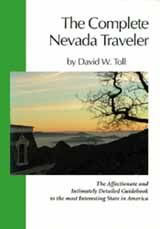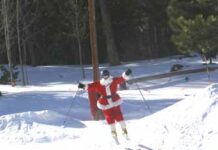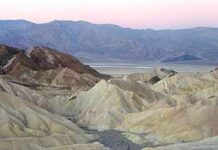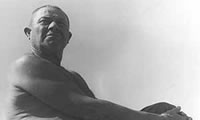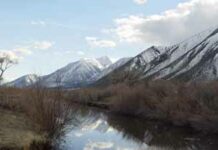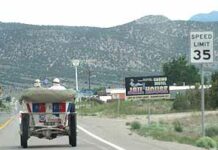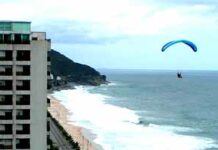What They’re saying About Us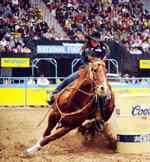 Via Magazine Visits the National Finals Rodeo. |
| Sign Up for our NevadaGram here. |
Now for some time travel. Buckle up, please.
While cleaning out an old building in Virginia City a few years ago, Winson Hong made a fascinating discovery. He found an advertising calendar from 1909, the inexpensive kind with the sponsor’s advertising and an illustration printed on a piece of card stock, and a small pad of 12 sheets, each one containing the dates for a month, stapled to that. The first two monthly leaves, for January and February, had been torn off, leaving March 1909 showing.
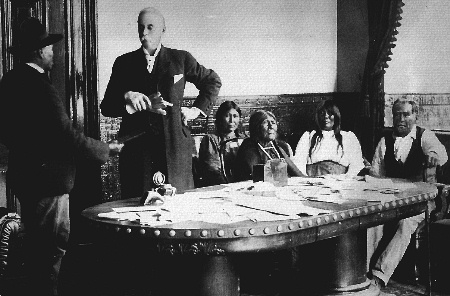
The sponsor of the advertising calendar was Self & Sellman Mill & Building Co. of Reno. In 1909 the firm’s lumber and building supply yard was at 335 E. Fourth Street. “Sash, Doors, Mill Work, Paints, Oils, Glass. Estimates Furnished Free.” The calendar supplied the phone number of the office (754) and the home numbers of each of the company’s principals: Lucian B. Self, President, (150) and Calvin Sellman. Vice-President, (998). Self & Sellman continued in business until 1910, after which Calvin Sellman is listed in the city directory as a building contractor.
What makes it fascinating is the illustration. Here’s the caption beneath the photograph: “Indian Johnny’s father, mother, two sisters and an interpreter appealing to Governor Sparks to save the life of their son and brother, who was executed for the crime of murder at the Nevada State Prison December 7, 1906.”
In the photograph the Governor is standing with his back to the family. Johnny’s mother looks like grief carved from granite, but all of them know what’s coming. They sit somber and silent. The governor has his gloves in his hand while the interpreter pleads for Johnny’s life. And isn’t he sneaking a look at his watch? Perhaps he has something important on his schedule.
At the Nevada Historical Society, we strap into a microfilm reader, and launch back to January 5, 1906.
From the Elko Daily Free Press:
From the officers we learn that the victim was a cripple, his left leg having been cut off near the hip. Detective Sullivan thinks from the description that he was a certain notorious crook. He was undoubtedly a hypo fiend as a syringe was found in his pocket. He was found lying across a fire with his back downward. and with several ties lying across his body. Part of his back, one arm and one side were literally cooked, the skin having burst and flesh protruded. His face was horribly slashed.
From the Wells Herald:
The throat of the murdered man had been cut from ear to ear, the head being almost severed from the body. The bones of both arms were broken, and the clothing cut and torn from the body and the shoe cut from his only foot, the left. Two crutches which the poor cripple had used were broken, being found one within and one without the low walls of the ‘tie-camp.’ . . .Two bloody knives, one a long bladed stiletto and the other a large keen-bladed pocket knife, were found lying where dropped by the murderers when they had finished their bloody deed. . . .
The supposition is that two or more men committed the foul deed. . . . It was believed that the men were on a west bound freight train which left Montello the morning of the murder.
We hurry along now to Elko, Saturday afternoon, March 27, and the gleaming oak-and-brass interior of the Elko County Court House on Idaho Street.
From the Free Press:
After a long and tedious trial covering a period of ten days, during which the counsel for the defense exhausted every effort to save them from the hangman’s noose, the case went to the jury Saturday afternoon at 4:30 o’clock and after deliberation lasting about two hours a vote was taken. It required but one vote to reach a verdict, and that verdict was murder in the first degree. . . .
When the prisoners heard their fate they broke down for the first time. The air of nonchalance and indifference which had characterized them throughout the trial disappeared and they seemed to fully realize their position. Neither is now inclined to talk of the affair and Ibapah has done little but sit and cry since he learned of the verdict. Johnnie is less demonstrative. . . .
Now that the men have been fairly tried and convicted, justice should be satisfied at an early date and at as small a cost to the county and state as possible. The spirit of the poor crippled stranger should not be caused to cry out long for vengeance.
From the Reno Evening Gazette October 31, 1906:
Johnnie and Ibapah, the Indians who killed a white stranger at Montello, Elko County, last winter, passed through Reno to enter the death cell at Carson. They will be hanged together on December 7th. The young fellows were securely manacled and heavily guarded, but they made no effort to get away. With the peculiar stoicism of their race they are resigned to their fate.
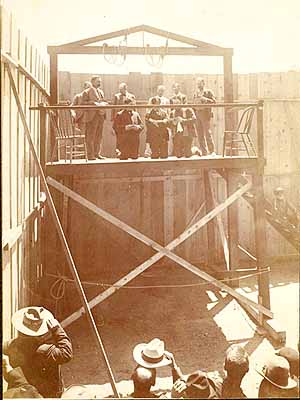 “We’ll hang next month,” said Ibapah stolidly. “Yes, we killed the fellow alright. I cut his throat and Johnny held him down.”
“We’ll hang next month,” said Ibapah stolidly. “Yes, we killed the fellow alright. I cut his throat and Johnny held him down.”
Ibapah says the ghost of a man who was hung at the prison this year came to his cell in the night and talked to him. He talks seriously about the ghost, which was that of a white man, he says.
Ibapah is a boyish-looking Indian of the Goshute Tribe. He is a half-breed and is about 17 or 18 years old. Johnny is a bulky little Shoshone, about five or six years older. . . .
The Board of Pardons refused the bucks clemency, although Johhny’s old parents journeyed all the way to Carson to implore mercy from Governor Sparks.
Now to the prison yard in Carson City, noon, December 7, 1906:
From the Nevada Appeal:
The law has been vindicated on two of the most atrocious murderers that ever went to the scaffold, and those that saw the execution will always believe that the law in this case failed in its purpose. Both victims were ignorant and half savage degenerates that are better out of the world, but neither of them seemed to realize the purpose of the execution. . . .
Johnnie, the larger of the two, and an evil looking brute, laughed and talked with the the guards and ministers around him for a moment and then broke out in curses as he stalked around the guard room, the central figure for once in his life of a circle of white men. . . .
For once in his life, just as he was about to leave it, Johnnie, Indian, outcast, low fellow, got everything he wanted. Fat and disdainful, he enjoyed his brief hour of triumph to the last sweet second.
Ibapah, on the other side of the room, talked little and walked often to the door where he peered through the iron bars for the last few moments left to him. . . .
The condemned men were led to the traps, Johnnie on the right, and without a word from any person the hangman affixed the noose to each and put the black cap in place. He turned after this to the warden, who nodded his head when all was ready. The hangman took one more quick glance to see that all was prepared, and raised his hand.
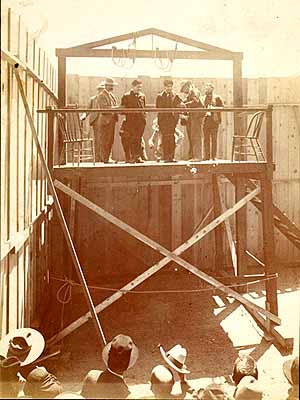 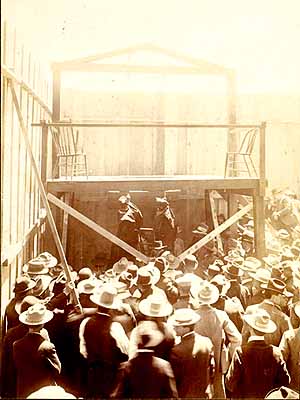 |
The two traps dropped with a terrific crash. . . .
Thus died two murderers whom the Commonwealth of Nevada has exhausted every recourse of its courts and executive powers as a matter of sentiment. They were the first Indians executed in this state by due process of law.
We’re back now, in the present tense. Unbuckle from the microfilm reader and replant both feet in tempus firmus.
It’s interesting to see the murder victim change from being “a certain notorious crook” and a “hypo fiend” into “a poor crippled stranger” after the killers were determined to be “ignorant and half savage degenerates”.
Question: whatever possessed Lucian B. Self and Calvin Sellman to use that photograph of Indian Johnny’s family vainly imploring Governor Sparks on their advertising calendar? Did it sell a lot of lumber and glass? Did they have the contract for the gallows?
About the photographer: How did he happen to be in the Capitol building that day, and why did he take that picture? Was he the same one who took the gallows photos?
A final question: Why were only two months torn off the calendar? My theory: the husband brought it home from a trip to the lumber yard in Reno late in 1908, and after the New Year he put it up on the wall. It took his wife two and a half months to get it down, and to hide it away in the back of the dresser drawer where Winson Hong found it all those years later. When last seen it was framed and on display in his Virginia City shop, the only public remembrance in all the world of Indian Johnny.
End time travel. Please watch your step.
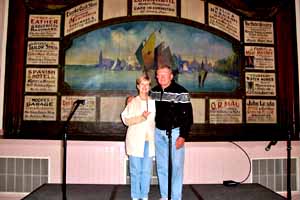
We got back from our trip on Monday, Oct. 19th. While we completed our Route 50 trip from Chesapeake Virginia to Sacramento California, we were only able to ride our Harley for 1600 miles of it.
We got caught in a torrential downpour on October 8th after staying overnight in Salem Illinois. We decided to ride as far as we could and ended up riding a little over 300 miles that day. It seemed like the rain was the heaviest in areas where there were no hotels.
The farther west we got, the weather improved greatly and it was a great ride all the way into Dodge City Kansas. We pulled up to our hotel and while unpacking our bike, we were told that they were expecting snow the next morning! After a very unrestful night we woke up to sleet and a wind chill of 17 degrees. Since we had already overworked our guardian angel, we decided that the most logical and safest thing to do was to leave our bike at the Harley dealership there in Dodge City where we could arrange to have it shipped home and rent a car to continue our trip on Route 50.
Easier said than done. After calling the only two rental car agencies in Dodge City, their answering machines informed us that they were closed on the weekends. We ended up renting the smallest U-Haul available that Saturday morning…a ten foot truck that is advertised to move a one bedroom home. We drove that to Colorado Springs where we were finally able to rent a car. This really brings new meaning to “getting the hell out of Dodge.”
While we would have loved to have completed the trip on our bike, the stress of all the weather changes was taking all the fun out of it. Riding the second half of our trip in a Ford Edge made it enjoyable again. We completed our Route 50 portion in Sacramento and went on to San Francisco so we could say we went Coast to Coast.
I will say that my very favorite day was the ride through Nevada. We picked up our “I Survived Route 50” book in Ely and got all our stamps. We took a little time in each city to look around and enjoyed the points of interest that were described in the book, especially the Opera House in Eureka.
We were intrigued by Route 50 since we heard about Tom Brokaw traveling this route for a special he is doing for USA network. We had toyed with riding Route 66 but since it is so fragmented it lost some of its appeal. A straight route through middle America seemed perfect to us. It was!
Bill & Moe
Chesapeake, Virginia
Quick notes from beyond the mountains:
In a recent NevadaGram I pointed out some geographical confusion in Michael Connelly’s next-to-latest mystery, “The Scarecrow” in which, among other things, he mixes up US 93 with US 50. In the video he made outside Las Vegas to promote the book (left) he again confounds the highways, and introduces a new
error. Play the video and you will hear the announcer read solemnly from page 135: “I headed north through the desert on Highway 93 toward E-ligh State Prison.” Ahahahahaha! In an interview in January Magazine Connelly stated: “The only real physical or on-location research I ended up doing was in Mesa, Arizona, and in the desert north of Las Vegas, off the highway known as the Loneliest Road in America.” Which, not to beat a dead horse, it isn’t; US 50 is “The Loneliest Road in America” (a moniker bestowed many years ago by LIFE Magazine) and he drove north from Las Vegas on US 93. If this is the result of his on-location research, it’s just as well he gave up journalism for fiction. And the fact is, he writes great reads . . .
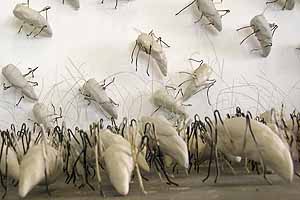
I think I am right in saying that only one Nevadan has both received a Nobel Prize and had a crater on the moon named for him: Albert Michelson was born in Strzelno in the Kingdom of Prussia, spent his boyhood in Virginia City, graduated from high school in San Francisco and then from the United States Naval Academy in 1869. He served as a naval officer for eight years and then resigned to become a professor of physics at the Case School of Applied Science in Cleveland, Ohio. In 1907 he was the first American to be awarded the Nobel Prize in Physics, principally for his work measuring the speed of light . . .
And who knew that the world’s largest landfill is located just east of the Las Vegas Valley? It accommodates 9,000 tons of fresh trash every day, down from 15,000 when the economy was humming . . .
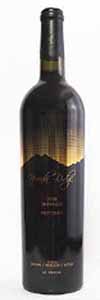 Pahrump Valley Winery‘s 2005 Nevada Ridge Zinfandel won “Gold” at this year’s Pacific Rim International Wine Competition. The Winery has racked up 51 national wine awards in 2009, including 10 gold, 21 silver and 20 bronze medals. Two gold medals went to the winery’s 2005 Syrah, four more went to 2007 Symphony, two to the 2007 Peak White, and another to the Crème Sherry. The winery was founded in March 1990, and now more than 1,500 vines of Zinfandel and Syrah grapes flourish at the western foot of Mt. Charleston at 3810 Winery Road in Pahrump. Open daily for tours, tastings, and weddings by arrangement: 800-368-9463 or 775-751-7800 . . . You should probably get your reservations in for the Carson Valley Inn‘s 24th Annual Sporting Clays Shooting Outing and Game Feed February 18 – 20. The extended weekend includes two days of shooting at two different clubs, 250 clay targets, an abundance of hearty food and $2,000 in cash prizes. Details of the $389 per person shooting outing hotel package here.
Pahrump Valley Winery‘s 2005 Nevada Ridge Zinfandel won “Gold” at this year’s Pacific Rim International Wine Competition. The Winery has racked up 51 national wine awards in 2009, including 10 gold, 21 silver and 20 bronze medals. Two gold medals went to the winery’s 2005 Syrah, four more went to 2007 Symphony, two to the 2007 Peak White, and another to the Crème Sherry. The winery was founded in March 1990, and now more than 1,500 vines of Zinfandel and Syrah grapes flourish at the western foot of Mt. Charleston at 3810 Winery Road in Pahrump. Open daily for tours, tastings, and weddings by arrangement: 800-368-9463 or 775-751-7800 . . . You should probably get your reservations in for the Carson Valley Inn‘s 24th Annual Sporting Clays Shooting Outing and Game Feed February 18 – 20. The extended weekend includes two days of shooting at two different clubs, 250 clay targets, an abundance of hearty food and $2,000 in cash prizes. Details of the $389 per person shooting outing hotel package here.
Overheard at the Wabuska Saloon in Wabuska: “Here’s the thing, Billy: Life isn’t about finding yourself, it’s about creating yourself.”
Happy Highways,



